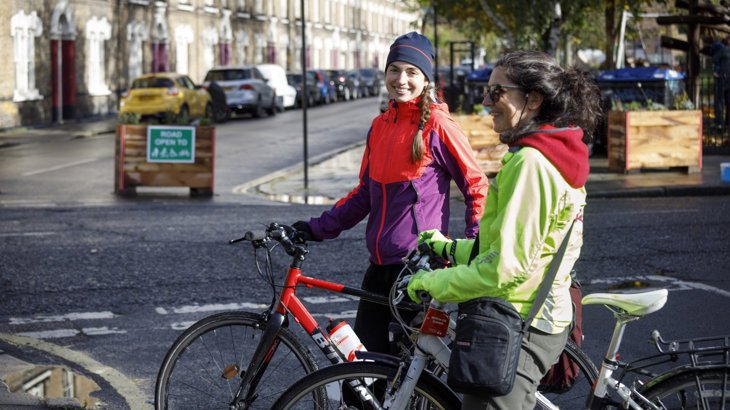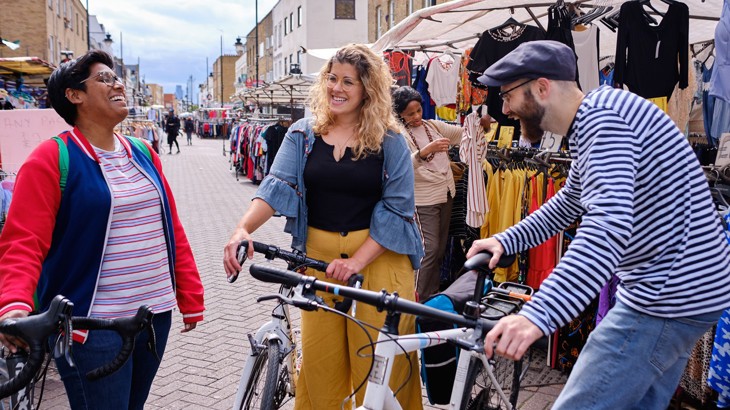Lucy Saunders is a public health specialist, transport planner and creator of the Mayor of London’s Healthy Streets Approach. Here she highlights the importance of behaviour change measures such as cycle training and personalised travel planning if we are to see more people choose cycling and walking over driving.

Behaviour change initiatives alongside well-designed infrastructure will help build healthier, happier, more equitable towns and cities.
Together, Transport for London and Sustrans have created a network of Healthy Streets Officers.
They are helping boroughs across London with their behaviour change programmes so residents feel more confident to walk and cycle their everyday journeys.
Creating healthy streets for people
I have spent much of my career developing the Healthy Streets Approach.
It's an evidence-based framework that shows how boroughs can put people at the heart of decision-making in transport and planning.
People designing our streets should be satisfied that their designs meet all10 indicators listed in the approach, to be truly healthy places to live.
But alongside building infrastructure to prioritise people over cars, we need to make it easier for people to change their travel habits.
There’s more to changing people’s habits than building cycle lanes
The government’s Gear Change vision for walking and cycling and its accompanying design guidance are clear that money will only be released to local authorities for delivering high-quality infrastructure.
This is really welcome because we know from decades of experience that pleasant and safe spaces for walking and cycling mean that more people choose more active ways of getting around.
But a major part in changing the way people travel is not only about street design.
It’s about helping people change their habits through behaviour change programmes specially tailored to their needs.
Supporting people to swap the car for a cycle or walk
Building people’s confidence is critical in helping them change their travel habits.
Advising them on how to make sure their cycle is adjusted to fit them is important when it comes to making them feel comfortable with the thought of swapping petrol power for pedal power.
Showing them ways to make sure the saddle and handlebars are at the right height and ensuring they have a good lock all help people to make the switch.
Providing people with cycle and walking-friendly route maps can give a huge confidence boost.
And actually getting them out on the streets with a more experienced walking or cycling buddy can be the best demonstration that car-free journeys are more than possible for them.
How Healthy Streets Officers are helping people to change the way they travel
Transport for London’s Healthy Streets Officers have been working across the majority of London boroughs.
They support people to make the most of the new street changes by helping them make their everyday journeys to the shops, school, work or their local park, on foot or by cycle.
Evidence shows that infrastructure alone is not enough.
I have been advocating an approach that includes changing social practices for over a decade, but rarely seen it applied until now.

Building people’s confidence is critical in helping them change their travel habits.
Here’s a taster of what the Healthy Streets Officers are doing
Coordinating the roll-out of over 100 London school streets
This is tackling school run pollution, congestion and encouraging children and their families to be active throughout the day.
Providing people with training
This helps them cycle their everyday journeys more confidently.
Helping workplaces
They work with places like hospitals to support staff, visitors and clients to walk and cycle by helping with planning quiet routes and providing cycle maintenance.
Co-ordinating a Try Before you Bike scheme
This allows people to try out a bike before investing in it. The scheme also includes payment plans to spread the cost over a period of time.
Behaviour change initiatives like these alongside well-designed infrastructure will help build healthier, happier, more equitable towns and cities where the benefits of reduced vehicle traffic can be enjoyed by everyone.
Resourcing effective change
Gear Change mentions support for cycle training; steps that can be taken to reduce bike theft; and encouraging GPs to prescribe exercise.
But we need a dedicated resource to make these ideas a reality. In London, the TfL-funded Healthy Streets Officers are that resource.
We need to see this type of support for councils up and down the country to ensure the residents in the UK’s diverse towns and cities benefit from being able to travel more actively.
2020: the year we changed how people travel
The year when Covid hit has been a year like no other.
The layout of our streets has needed to change rapidly in response to people’s changing transport habits due to the pandemic.
With less capacity on public transport and the need to avoid car-congested streets and worsening air pollution, local authorities are dedicating more space to walking and cycling as part of Transport for London’s Streetspace programme.
The government and Transport for London have been pushing to speed up the installation of infrastructure to encourage more people to walk and cycle rather than drive.
And this is providing councils with an unprecedented opportunity to create places designed for people, not cars.
Incorporating community-centred behaviour change initiatives such as led rides and cycle training will mean we can look back on 2020 as the beginning of the step change in delivering Healthy Streets.
A time when we started to make a difference, tackling the climate emergency and making our neighbourhoods fairer places.

It’s time to talk in terms that the public care about. Talk about how their streets look and feel.
Speaking the public’s language
So, if you are a transport professional or are in a position to influence how our towns and cities work, it’s time to talk in terms that the public care about.
Talk about how their streets look and feel.
How their towns can evolve away from channelling motor traffic to being places people feel proud of and where they like to spend time.
Put resource into helping communities make the most of the changes and reimagine our streets for a better healthier and greener future.
Healthy Streets Officers are here to help
Contact your borough's Healthy Streets Officer or make sure that there are behaviour change officers working to support local authorities in your area.
And finally, make that extra effort to align your communications, behaviour change programmes and physical street alterations with the Healthy Streets Approach.
Find out more about London’s Healthy Streets Officers and how they are working with boroughs.
Take a look at the Mayor of London’s Transport Strategy to see how Lucy Saunders’ Healthy Streets Approach informs how streets should be designed for the benefit of everyone.

Lucy Saunders is a public health specialist who developed the highly influential Healthy Streets Approach to how we use, plan and manage our transport system and public spaces. It puts people and their health at the heart of decision making to create neighbourhoods where people choose to walk, cycle and spend time.





